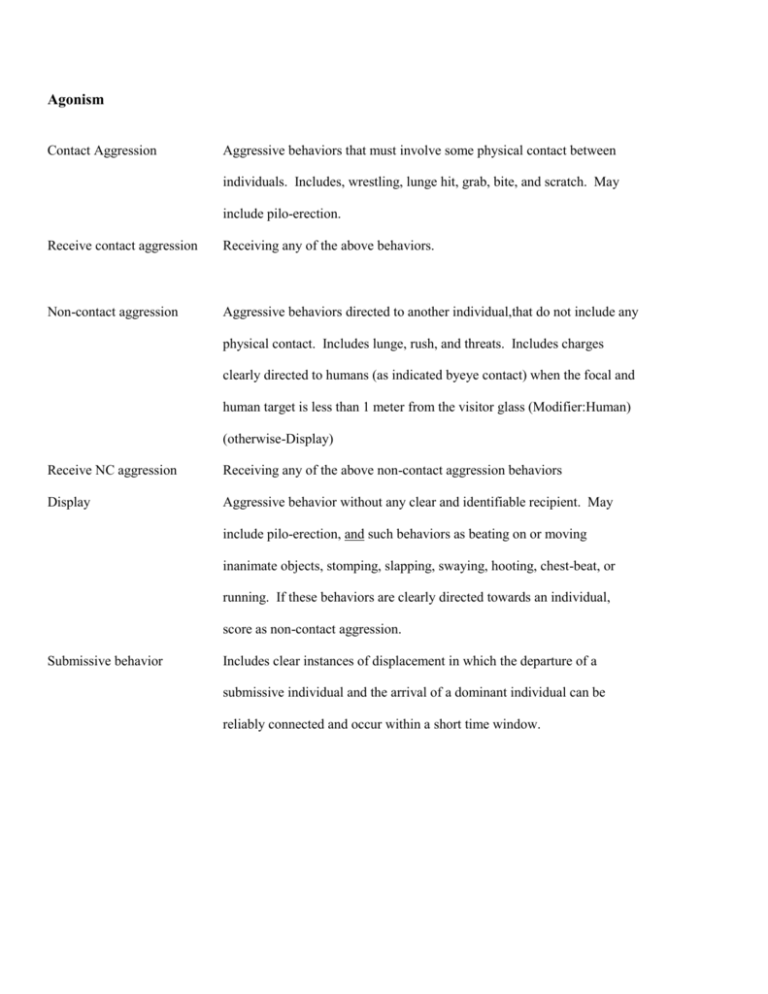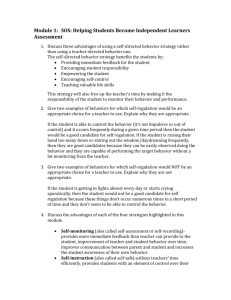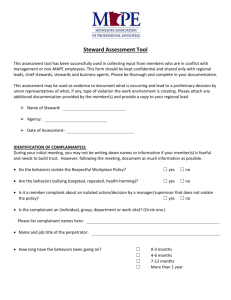
Agonism
Contact Aggression
Aggressive behaviors that must involve some physical contact between
individuals. Includes, wrestling, lunge hit, grab, bite, and scratch. May
include pilo-erection.
Receive contact aggression
Receiving any of the above behaviors.
Non-contact aggression
Aggressive behaviors directed to another individual,that do not include any
physical contact. Includes lunge, rush, and threats. Includes charges
clearly directed to humans (as indicated byeye contact) when the focal and
human target is less than 1 meter from the visitor glass (Modifier:Human)
(otherwise-Display)
Receive NC aggression
Receiving any of the above non-contact aggression behaviors
Display
Aggressive behavior without any clear and identifiable recipient. May
include pilo-erection, and such behaviors as beating on or moving
inanimate objects, stomping, slapping, swaying, hooting, chest-beat, or
running. If these behaviors are clearly directed towards an individual,
score as non-contact aggression.
Submissive behavior
Includes clear instances of displacement in which the departure of a
submissive individual and the arrival of a dominant individual can be
reliably connected and occur within a short time window.
Sexual
Social Sex
Includes any component of a series of sexual behaviors including mounting,
thrusting and complete copulation. May occur with or without full
penetration. Includes unsuccessful copulations due to incorrect orientation
or unreceptive partner. Includes homosexual mounting.
Masturbation
Actively using a body part, object, or part of the cage to stimulate own
genitals, with clear accompanying evidence of pleasure or arousal (baredtooth grin-like expressions, screams, etc.). Does not include manipulation
of the genitals (Sexual Exam) or grooming around the genital area
(Solitary-Self).
Abnormal
Deliberate ingestion of feces from the self or another individual. Includes
Coprophagy
instances when the subject catches or holds feces as it is excreted,
manipulates feces, or “paints” with feces on an exhibit surface.
Abnormal Plucking
Pulling out own or another animal’s hair; may be ingested. Does not
include single hairs pulled out incidentally during self-directed or grooming
behaviors.
Abnormal body posturing
Repeated, sustained and purposeless manipulation of a specific area of own
body, such as eye-poking, self-patting, ear-covering.
Abnormal Movement
Repeated and sustained movement of body, such as rocking or necktwisting, with a definitive repetitive pattern.
Social
Social Play
Non-aggressive interactions involving two or more animals. Never
accompanied by pilo-erection or agonism; may be accompanied by playface and/or laughing. Includes rough-and-tumble play (fast-paced, vigorous
locomotion, wrestling, hitting, pulling, chasing, biting, etc.), quiet play
(slower-paced, gentle-tickling, finger and toe manipulation, etc.). May
involve the use of an object.
Social Groom Give
Picking through hair or at skin of another individual and removing debris
with hands and/or mouth. Does not include plucking hair or self-directed
behaviors. Includes grooming a conspecific with an object (e.g. comb,
stick)
Receive social groom
Receiving social groom (see above). If two individuals are mutually
grooming, record as Groom. Includes being groomed by a conspecific with
an object.
Prosocial
Individual interacts with another in a social way that cannot be more
specifically classified. The non-focal recipient individual may be nonresponsive. If subject is the non-responsive recipient, the behavior is
recorded otherwise. Prosocial interactions with “Human” as modifier are
limited to begging gestures, active chasing games, or re-assurance seeking
from a human, all when both human and ape are within 1 meter of the
barrier. Gestures directed to the observer are excluded (instead e.g. Inactive,
etc). Does not include attention to a human, a human’s body, or an object
held by a human (attention keeper/visitor).
Solitary Behaviors
Self-groom
Picking through, touching, or rubbing own hair or skin and removing debris
with hand, foot and/or mouth. Does not include plucking hair (Pluck) or
scratching. Includes behaviors that induce and precede regurgitation that
involve self-contact (lip rubbing, etc.). Using an object to touch, groom or
rub the body is designated Object-Body.
Solitary Play
Individual may play by itself with hands, fingers and toes, other body parts,
or use an object as the focus of or tool for play. Typically includes
playful, vigorous and exaggerated movements with no clear purpose.
May be either boisterous or quiet (spinning, somersaulting, vigorous
shaking of blankets).
Inactive
Individual is not moving and not active in any other behaviors listed. Eyes
may be open or closed. Includes instances during which a subject holds or
carries an object (including food or water), without actively manipulating it
(including chewing or swallowing).
Attention
Individual maintains gaze directed towards an individual or an area for
longer than 3 seconds while within 1 meter of barrier.
Locomotion
Individual changes location in a horizontal or vertical space by moving.







